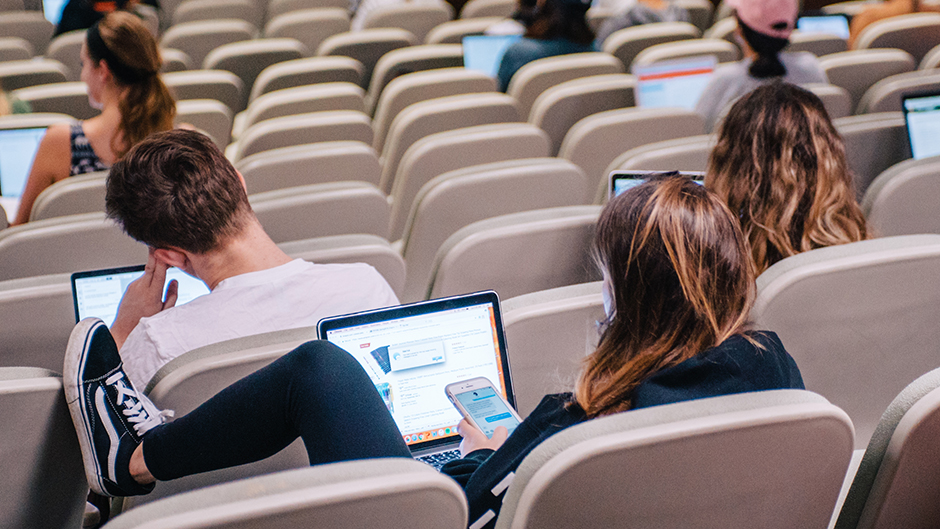University of Miami sophomore Jack Btesh waits for his Pre-calculus class to begin with his MacBook laptop in front of him and his iPhone in hand. The minute class begins, he closes the laptop but he cannot help but keep an eye on his texts.
“Using electronic devices is our lives,” he said one recent morning. “I won’t answer the text during class, but I do check it just in case it is important.”
His instructor Sergio Hernandez, a lecturer in the math department, said that letting the students use electronic devices is something he “tolerates. After all, they are adults.”
Using modern technology, specifically laptops, tablets and iPhones in the classroom is a dicey issue on many university campuses. At UM each faculty member reserves the right to ban such devices from their classrooms and they often do so, including policy in their syllabus as a condition for participation.
At a time in which recent studies show that young people are addicted to their iPhones and a company called Yondr charges a fee to lock away the device and provide a “device free” hour or two, the use of these devices has come under scrutiny.
“I only allow cell phones or computers in the classroom if we have a specific in-class activity that requires it,” said Nina Miville, assistant professor in practice in the Industrial Engineering department at the College of Engineering. “Otherwise, they are not allowed to use it.”
The benefits of technology, via laptops and iPhones, is undeniable. Research can be instantaneous, access to online learning platforms such as Top Hat can allow professors to administer quizzes to student devices directly, project videos and graphs and conduct polling for collective learning.
Integrated technology can enhance the classroom experience depending on how the instructors use the technology, said Allan Gyorke, associate vice president for Information Technology and assistant provost for Educational Innovation.
“For example, in a writing course, faculty could have students bring in their laptops to do writing and editing during class time,” Gyorke said. “In an architecture course, students could bring their laptops to work on CAD (Computer Aided Design) drawings or show their 3D rendered scenes to other students. In these cases, technology is an integral part of the creation process and appropriate for that reason.”
But many professors experience the downside of allowing electronic devices, especially in large classes, where many students try to hide their iPhone on their lap or open their laptops to sites that have no tie to the classroom work and create a distraction to themselves and others.
“I have stopped allowing laptops and tables and iPhones in class,” said Sam Terilli, associate professor at the School of Communication. “I insist on my favorite technology for notetaking…papers, pens and pencils.”
Although he has experimented with technology, Terilli noticed that students who took notes on their laptops became stenographers, trying to write every word.
“Instead, I want them listening, thinking and synthesizing ideas and then taking just a few notes,” he said. His method is actually scientifically proven to be beneficial. A 2014 study by professors from Princeton and the University of California, Los Angeles, determined that taking handwritten notes allowed more effective learning than using laptops. The study also revealed that students who multitasked during classes had reduced comprehension of course material.
Aaliyah Weathers, a junior studying journalism and motion pictures, can attest to the study’s results. While in class she is constantly monitoring her emails and other texts.
“I try to multitask because I belong to two organizations and I have two jobs and my attention is getting pulled into many different directions,” she said. “But it is easy to be distracted while doing that. You just have to snap out of it and return to class.”
When she took Terrilli’s class “Freedom of Expression” and was forced to put the electronic devices away and take notes longhand, she found that she retained more information and did not have to spend a lot of time studying before a test.
She also earned an A in the course.
Some professors, like Alberto Cairo in the School of Communication who teaches information graphics and visualization, find that the use of technology can increase a student’s creativity by exposing them through Google searches and other tools to the work of creative people from all over the world.
On the other hand, other professors restrict the use of electronic devices because they have noticed that it can cramp a student’s creativity.
Marilyn Neff, retired dean of Planning, Communications and External Relations at the School of Education and Human Development, who still teaches at the school, banned electronic devices from her “Education and the Arts” class when she noticed that many students – instead of engaging with the art (clay, paints, crayons) – wanted to look at their phones instead.
“My class is hands-on and they have to work with the materials,” said Neff. ”I think often when they are so hooked up on the technology it can restrict their growth, their creativity. I asked them to use green clay to create an object and many of them wanted to look up in Google what others had made with green clay.”
For those professors who are still pondering whether to use technology or not and whether it can help or hinder teaching, Gyorke has a suggestion: “They can contact me and I’ll set them up with a consultation with an instructional designer who can talk with them about their courses, what they would like to accomplish, and ways to achieve their goals either with or without technology.”

